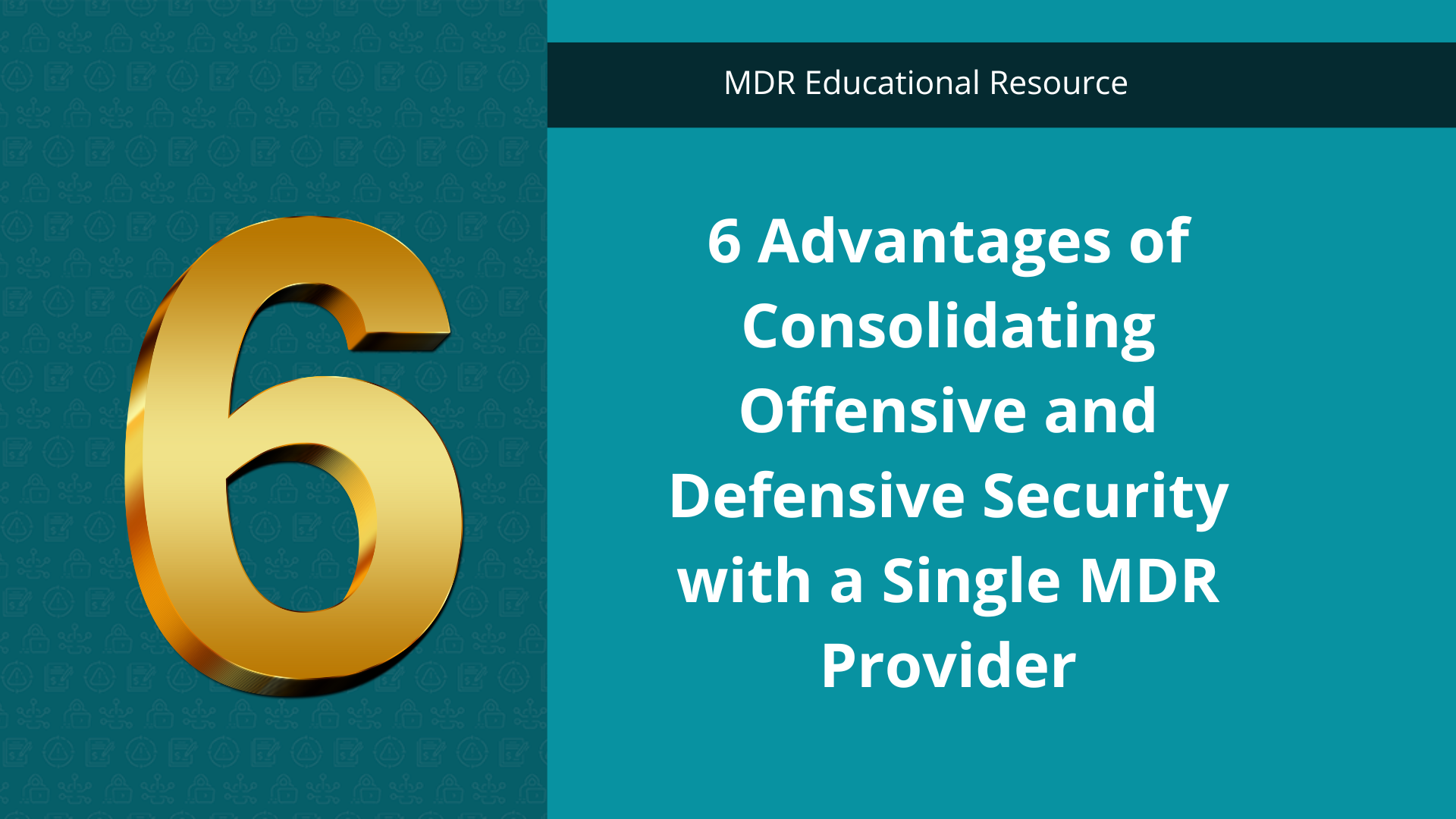According to the FBI’s Internet Crime Report, more than $10 billion was lost in cyber attacks in 2022, up from $6.9 billion in 2021 and $4.2 billion in 2020. This precipitous increase in losses from cyber crime is alarming, but there are a variety of strategies organizations can implement to protect their systems from online threats.
Partnering with a cybersecurity vendor for managed detection and response (MDR) is one such strategy. An MDR service provider leverages specialized software and professional experience to prevent malicious actors from accessing your data. They also detect potential threats and mitigate the impacts if a breach does occur.
Some organizations work with a separate vendor for offensive security services, like penetration testing and red teaming. However, as times change and threats evolve, there is a growing case for organizations to engage a cybersecurity vendor that offers an integrated MDR approach, combining offensive and defensive security services to provide more comprehensive protection against potential threats.
What is offensive and defensive security?
Defensive security focuses on implementing measures to protect systems, networks, and data from unauthorized access, attacks, and other security risks. Elements of defensive security include firewalls, intrusion detection systems (IDS/IPS), encryption protocols, access controls, and incident response procedures.
The primary goal of defensive security is to prevent or minimize the impact of attacks, safeguard sensitive information, and ensure the overall integrity and availability of systems. The majority of traditional MDR services would be considered defensive security.
Offensive security, also known as “hacking with permission” or “ethical hacking,” involves actively seeking and attempting to expose vulnerabilities in computer systems, networks, and applications. The goal of offensive security is to proactively uncover weaknesses and strengthen defenses before an actual hacker exploits those weaknesses.
Both offensive and defensive security play a crucial role in fortifying the safeguards protecting an organization’s digital assets, and combining them through a single service provider offers many benefits for organizations looking to strengthen their cybersecurity posture.
6 Benefits of Integrating Offensive and Defensive Security
-
Comprehensive Coverage
Defensive measures focus on protecting against known threats, and offensive measures simulate real-world threats to uncover vulnerabilities that might evade traditional defenses. Using a single MDR service provider that offers both offensive and defensive security services provides a holistic and well-rounded approach to protecting your systems and data.
-
Proactive Threat Detection
Offensive security practices, like ethical hacking and penetration testing, are designed to help you detect threats proactively, rather than reactively. By integrating these practices with defensive security measures, organizations can find and fortify potential entry points and security gaps before malicious actors exploit them.
-
Enhanced Vulnerability Management
While defensive actions address known threats, offensive security tactics reveal vulnerabilities from an attacker’s perspective. Malicious actors are always looking for ways around traditional cyber defenses, so layering in offensive measures enhances your ability to manage unseen vulnerabilities and reduce the risk of successful attacks.
-
Realistic Testing Environments
Offensive security measures allow cybersecurity professionals to assess security measures in a controlled environment that closely resembles a real-world attack scenario. When your defensive and offensive security comes from the same MDR vendor, that vendor will be able to better understand your unique situation and accurately assess the effectiveness of your security efforts.
-
Streamlined Collaboration and Communication
Working with a single service provider for both offensive and defensive security simplifies collaboration and communication between teams. With just one vendor, you can have a seamless transfer of information between offensive and defensive teams, and it’s easier to agree on a cohesive, unified approach. Ultimately, effective collaboration facilitates faster response times and better outcomes.
-
Cost-Effectiveness
Rather than engaging separate vendors for these services, organizations can leverage economies of scale by consolidating offensive and defensive security services through one MDR service provider. Additionally, integrating services can lead to more efficient resource allocation, reducing redundancies and optimizing overall security investments.
Things to Consider When Integrating Offensive and Defensive Security
Selecting an MDR service provider that offers both offensive and defensive security services can bring many benefits, but consider these potential challenges as you weigh your decision:
- Expertise and Skill Set: Look for an experienced team with a track record of delivering both offensive and defensive security services. Assess their qualifications, certifications, and accomplishments in supplying comprehensive cybersecurity solutions.
- Resource Allocation: Integrating offensive and defensive security services may require additional in-house personnel, training, or technology tools to manage. Make sure your team is prepared to make the transition.
- Ensuring a Good Fit: If your organization has unique security concerns, make sure potential service providers have the specialized knowledge to support you, and communicate your expectations regarding scalability, availability, and response times.
- Confidentiality and Data Handling: Ensure that the service provider has robust policies and practices in place to maintain the confidentiality of your data. Evaluate their data handling processes and relevant compliance certifications (e.g., GDPR, ISO 27001).
- Clear Communication and Reporting: Establish clear channels for communication and reporting. Regular reporting on vulnerabilities and remediation efforts should be part of any MDR service agreement.
- Potential Conflict of Interest: MDR providers should maintain objectivity and impartiality when conducting offensive security assessments — especially if they’re also administering defensive solutions. To avoid conflicts of interest, voice your concerns and define the rules of engagement.
- Regulatory and Compliance Considerations: Many organizations are required to adhere to specific regulatory and compliance requirements. Choose an MDR provider with a strong understanding of your industry’s specific compliance needs.
- Continuity and Disaster Recovery: When an incident occurs, effective business continuity and disaster recovery are paramount. Ask MDR providers about their processes and procedures for minimizing downtime and mitigating the impacts of a potential security breach.
Not every MDR service provider offers a combined offensive and defensive approach, and not all vendors will be a good fit for your organization’s needs — that’s okay. Most vendors will be happy to answer your questions and address any concerns to ensure you’ll have an effective partnership.
Choose an Integrated Approach to Security
With the threat landscape continuously evolving and changing, protecting your systems is more important than ever. Your best line of defense — and offense — is a partnership with an MDR provider that offers integrated offensive and defensive security.
At CyberMaxx, our philosophy is that offensive security fuels defensive capabilities. MDR with integrated offensive and defensive security is the best way to discover threats, shore up safeguards, and reduce your overall risk. To learn more about our approach, reach out to our team.




